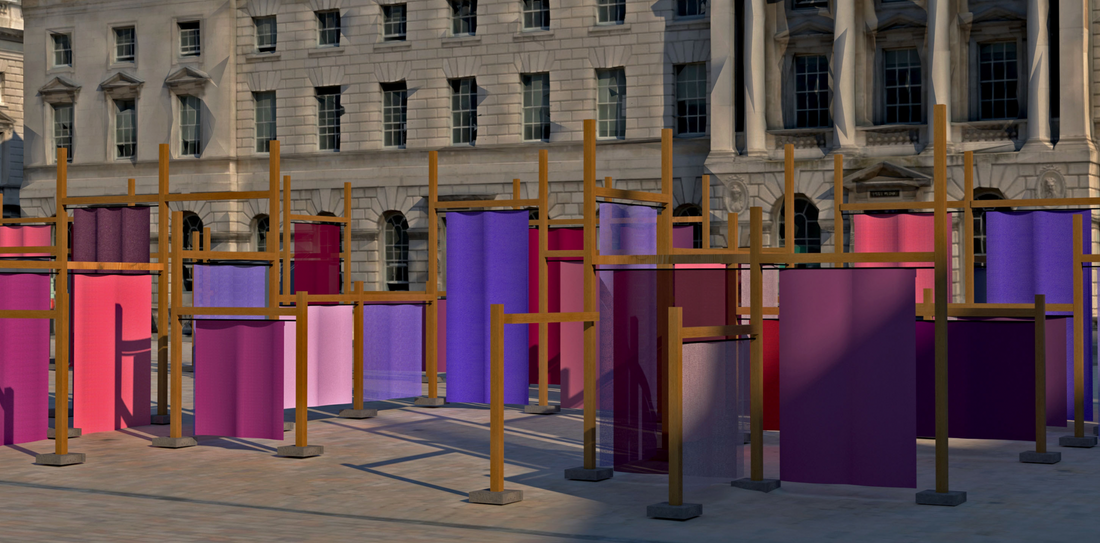
LONDON DESIGN BIENNALE: PAVILION OF MALTA
Urban Fabric is a large-scale ‘village-square’ installation that merges traditional city planning with the Phoenician-Maltese tradition of fabric production and dyeing of the multiple colours of Phoenician purple. The installation uses wood, recycled stone and organic fabric that is certified eco-friendly for its main components. These create a ‘street-like’ layout that enables the audience to meet and collaborate while interacting directly with the installation.

Urban Fabric was conceived through a fusion of art, architecture and innovative design, with the wider context of an original concept based on research that was carried out at the National Museum of Archaeology in Valletta. Here, the team retraced the footsteps of the Phoenicians, experiencing the fine fabrics and artefacts of the time and using this experience as foundation.
The installation uses source material documentation about how the Phoenicians used to dye wool and linen garments using (mainly) two types of sea-snail species which are common along the Mediterranean shores – the Murex trunculus and the Murex brandaris. The installation piece draws on eco-friendly methods as an alternative to ancient practices.

‘Urban Fabric’ strives to encourage discourse about the environment by presenting a well-researched, thought-provoking creative pavilion that combines aesthetic and spatial awareness with activism.
Through ‘Urban Fabric’, the team of architects, artists and authors aim to provide a space that changes and evolves by giving it an urban backdrop – allowing the quality and essence of these materials to come through more easily than it does through the concrete structures currently growing within the Maltese landscape.

Using natural materials as the main component, the team strives to instil the idea that humans should use these resources to their best potential within their set timespan, rather than trying to extend their duration through unnatural means. Through Urban Fabric, the artists aim to evoke a sense of memory and space, allowing for a more integrated thinking approach to material and urban fabric.

Urban Fabric was conceived through a fusion of art, architecture and innovative design, with the wider context of an original concept based on research that was carried out at the National Museum of Archaeology in Valletta. Here, the team retraced the footsteps of the Phoenicians, experiencing the fine fabrics and artefacts of the time and using this experience as foundation.
The installation uses source material documentation about how the Phoenicians used to dye wool and linen garments using (mainly) two types of sea-snail species which are common along the Mediterranean shores – the Murex trunculus and the Murex brandaris. The installation piece draws on eco-friendly methods as an alternative to ancient practices.

‘Urban Fabric’ strives to encourage discourse about the environment by presenting a well-researched, thought-provoking creative pavilion that combines aesthetic and spatial awareness with activism.
Through ‘Urban Fabric’, the team of architects, artists and authors aim to provide a space that changes and evolves by giving it an urban backdrop – allowing the quality and essence of these materials to come through more easily than it does through the concrete structures currently growing within the Maltese landscape.

Using natural materials as the main component, the team strives to instil the idea that humans should use these resources to their best potential within their set timespan, rather than trying to extend their duration through unnatural means. Through Urban Fabric, the artists aim to evoke a sense of memory and space, allowing for a more integrated thinking approach to material and urban fabric.
London Design Biennale 2023 is on until 25 June. Find out more on the event website: londondesignbiennale.com
Find out more about Urban Fabric at the London Design Biennale 2023: londondesignbiennale.com/pavilions/2023/malta
